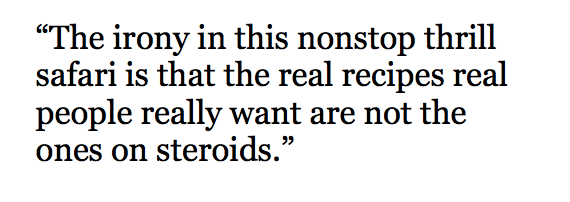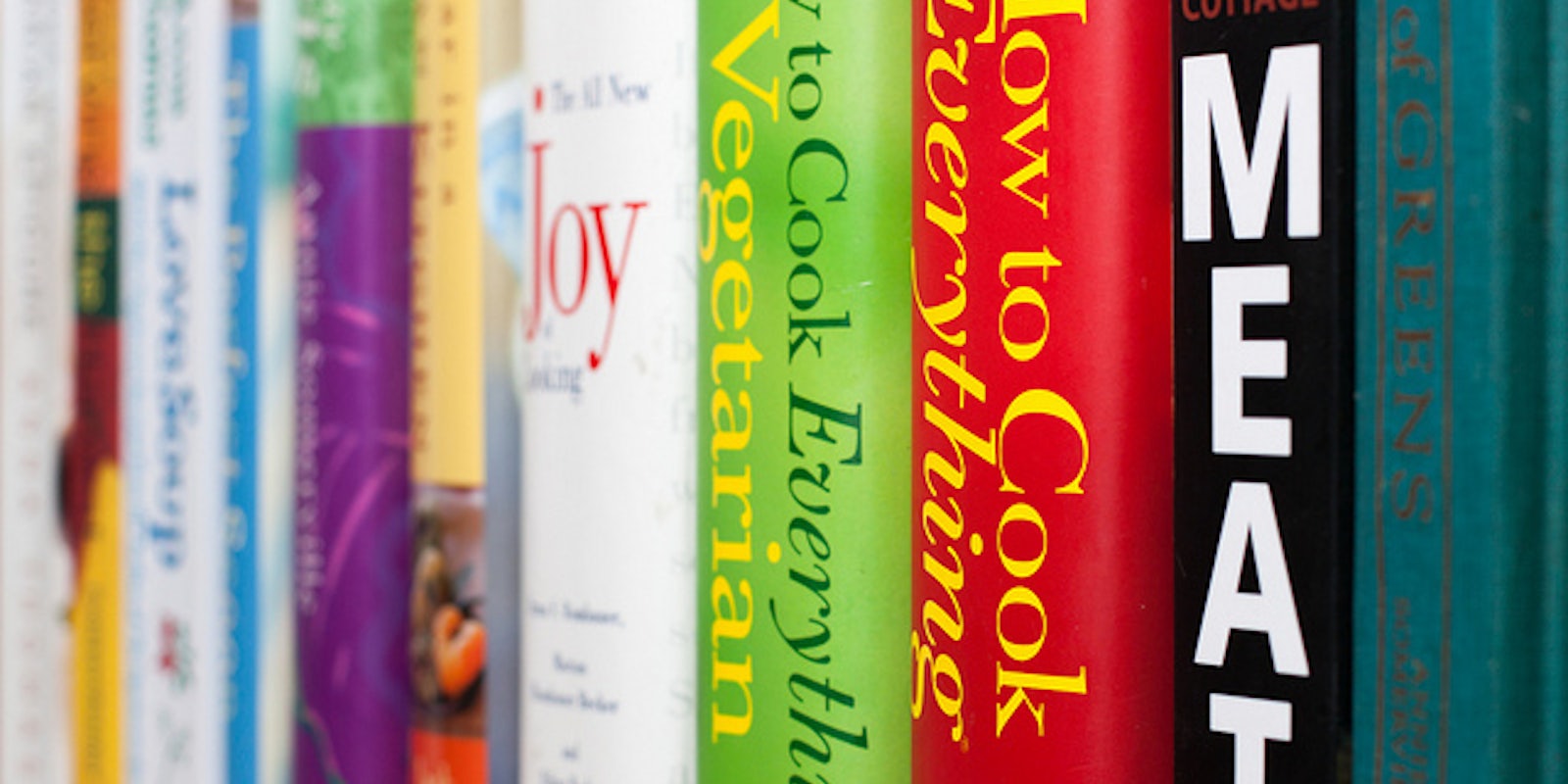By SANDRA GARSON
Part II of How the Internet killed the cookbook … and then resurrected it.
The death of the cookbook meant the boom of cooking content online. And now we’re coming back full circle. The sheer volume of food content online is staggering. The inescapable truth that humans have to eat makes food the lowest common denominator, a content provider’s wellspring. And while humans only need to eat two or three times each day to get by, the Internet’s hunger is insatiable.
Monthly magazines and weekly newspaper food sections have given way to an hourly changing of the lard. The infinite demand for instant content creates such fast, industrialized junk food for thought, so highly reliant on high fructose porn syrup, that food and recipe sites are often fraught with the same phoniness as online dating and bogus Facebook pages. Eleven sexy sliders! What you need to give up for the New Year so you can be healthier! (Hint: cheese doodles.) Decadent chocolate cakes! “When you wake up with a sugar craving on a weekend morning, it’s your right as a self-respecting human being to indulge it to the maximum. So we found 6 recipes that’ll probably do the trick. Remember: if less is good, more is better.”
And it’s far from reliable. Going for the kale Tuscan bean soup listed as vegetarian on one site could be your very own Manti Te’o moment when halfway through you find there’s chicken in it. Or there are moments like these, when this touted recipe writer begins her Celeriac Potato Gratin with the comment, “I love the aniseed flavor of celeriac. If you’re not a huge fan of aniseed, just omit the celeriac…” Well, LOL, because dear, there is no aniseed, and celeriac does not taste like licorice. Then there’s the weird blend of food promo and integrated advertising, with writers hocking product: the Huff Post RD who trumpets to everybody to buy a sugar cane product called Honey Crystals. 
This is what the massive media industry does for a living. To get our attention (e.g., money), it plates up extremes and feeds us exhilaration. It can’t supersize portions online, so it supersizes the entertainment value of food. Quaint old-fashioned bake-offs become throw-downs and take-downs, site editors post queries for “EXTREME desserts.”
We’re now smack in the culmination of the bowl season (orange, cotton, rose, sugar). So it’s no surprise the Internet uses football hype for its own bowls: the soup and salad. “Three variations on chicken soup as the super bowl!” “Hot Salads.” And of course every site insists it has the super duper dish you just gotta have to must should can’t miss eat while watching the game. One recent afternoon, site editors were crying out for Innovative Hummus: How it’s more than a spread or dip!; decadent chocolate cakes; aphrodisiac Latin-themed cocktails, the absolutely best can’t be beat Buffalo wings, and those extreme desserts. This is a spread even the Roman feasts of old couldn’t conceive of. A feast so infinite it’s becoming nauseating.
The irony in this nonstop thrill safari is that the real recipes real people really want are not the ones on steroids. The majority of clicks go to the timeless simple dishes of the old pre-amazing normal: deviled eggs, meatballs, chocolate chip cookies. Maybe Andy Warhol was right: “Progress is very important and exciting in everything, except food.” 
Maybe this is why cookbooks are coming back, despite all the moaning about their death a few years back. Today they remain a thriving industry, perhaps even more than ever. One surprised editor was recently quoted in the New York Times wondering why people were pumping up $35 to get the new Smitten Kitchen Cookbook when its the recipes were on the original blog for free.
Perhaps it’s because we need the cookbook again. We need the vetting, the packaging, the limitations of one book, of two covers. People are now willing to pay again to have cookbooks—because they put brakes on the wild, often reckless joyriding of the Internet. Cookbooks let you know who is talking and why it’s good. They’ve taken the time to simmer their offerings and taste them; there’s no chicken in that vegetarian soup. Last week, Jason Kessler weighed in on the debate about tasting menus by writing, “We set the starting point and the professionals fill in the rest. That way, we have both the freedom of choice and the benefit of expert knowledge all wrapped into a single package.” This is what cookbooks do for us, and why the public is once again craving them.
It’s true that we can have that on the Internet—it does exist. And it really does bring us to one, giant communal table. In a way, the Internet is a glorious cookbook all by itself. With the right perspective (what we Buddhists call “right view,” which means no extremes), you can get heaps of genuine, uncontrived excitement, finding food from far-flung places that you can create and taste in your own kitchen: discovering what you have in common with home cooks in Nepal or Mongoli, mastering knife skills, whipping creamed cheese. But in the midst of this vast, crazed cornucopia, it’s more important than ever to remember the most simple of all needs: that for many, just having food is all the excitement, all the thrill.
Sandra Garson is the author of Veggiyana, the Dharma of Cooking and How to Fix a Leek and Other Food from Your Farmers’ Market. She is the founder and president of the Buddhist food charity Veggiyana and maintains its news blog. She recently spent six weeks teaching vegetarian cooking in meat-obsessed Mongolia, and is working on a second helping of Veggiyana recipes and essays as well as a way to teach children the magic of cooking.
Photo by timsackton
